Lyndhurst Presents Alexander Jackson Davis Exhibition
by Howard A. Zar
Although largely unknown today, Alexander Jackson Davis was America’s preeminent architect of the first half of the 19th century. Davis came to prominence as practitioner of the Greek Revival style but later initiated the stateside practice of designing a Gothic Revival building’s exterior, interior, interior furnishings, furniture, and placement in the landscape. This breadth of focus is typically associated with Frank Lloyd Wright’s vein of Modernism.
Alexander Jackson Davis: Designer of Dreams, now on view at Lyndhurst mansion in Tarrytown, NY, explores Davis’s career through five of the most significant Gothic Revival castles he designed from 1838 through 1867: Paulding Manor (the first iteration of Lyndhurst), Walnut Wood (also known as the Harral Wheeler House), Ericstan, Belmead, and Lyndehurst (the second iteration of Lyndhurst).
At the center of the exhibit is Davis’s masterpiece, the 14,000 square-foot Lyndhurst mansion as well as the more than 50 pieces of furniture he designed for the house, which have never left. Additionally, more than 80 objects have been lent to the exhibition by some of the most prestigious decorative arts museums in the country, including The Metropolitan Museum of Art, the Avery Library of Columbia University, the New York Public Library, the Museum of the City of New York, the New-York Historical Society, the Cropsey Foundation, Historic Hudson Valley, Winterthur, and the Smithsonian.
Davis designed universities, museums, state capitols, and innumerable houses up and down the East Coast and as far west as Kentucky and Illinois. He became the chief advocate of erecting fanciful Gothic castles for his newly wealthy clientele, who benefitted from the trade provided by the Erie Canal, Northern industrialization, and the early expansion of railroads.
Davis was self-trained and came to architecture through art. His ravishing hand as an artist is visible in this exhibition, which includes many of the finely worked watercolor studies he prepared for his clients. Davis was also a significant designer of furniture. He developed innumerable pieces, either as suites for a few major rooms or for a whole house, and much of his furniture production survives. Many of his drawings for furniture still exist, and the exhibition displays extant pieces of furniture next to the original designs.
Davis also prepared illustrations of furniture for the publications of his collaborator Andrew Jackson Downing, the 19th-century tastemaker who was essentially the Martha Stewart of his time. Downing’s The Architecture of Country Houses (1850) was particularly influential. Some of Davis’s published designs were eventually made into furniture by Alexander Roux, one of the most important French émigré ébénistes working in New York prior to the Civil War. The exhibition displays one such chair designed by Davis for an illustration in Downing’s book that was possibly created by Roux.
The exhibition explores Davis’s career in the Gothic Revival through five of his most significant Gothic houses. Lyndhurst is pivotal to Davis’s career when viewed as the changeover from Classicism to Romanticism in the United States. Initially built in 1838 as Davis’s first fully executed Gothic castle, the architect returned to the property in 1867, at the end of his career, to double the house in size, essentially creating the first Gilded Age mansion for George Merritt, an early Railroad Baron.
The exhibition is displayed both in the Lyndhurst exhibition gallery and in the mansion itself, along with Lyndhurst’s extensive holdings of more than 50 pieces of furniture that Davis designed for the mansion. Of course, the mansion is the most important work in the exhibit.
This is a rare opportunity to experience Davis’s full oeuvre, the buildings and furniture he designed along with the preparatory renderings and construction notes—even correspondence between the architect and client—and executed pieces of furniture next to the original drawings from more than 175 years ago.
Alexander Jackson Davis: Designer of Dreams is on view at Lyndhurst through October 13, 2025. The exhibition catalog is available at the Lyndhurst gift shop and includes essays on Davis’s evolution and furniture production practices. It illustrates more than 80 works exhibited in the show. Requests for catalogs can be emailed to aboesch@savingplaces.org.
Howard A. Zar is the Executive Director of Lyndhurst, a National Trust Historic Site in Tarrytown, NY.
About The Decorative Arts Trust Bulletin
Formerly known as the "blog,” the Bulletin features new research and scholarship, travelogues, book reviews, and museum and gallery exhibitions. The Bulletin complements The Magazine of the Decorative Arts Trust, our biannual members publication.
Click Images to Enlarge
Did you know that clicking on the images in Bulletin posts will allow you to get a closer look? Simply click on an image, and a larger version will open in a pop-up window.













